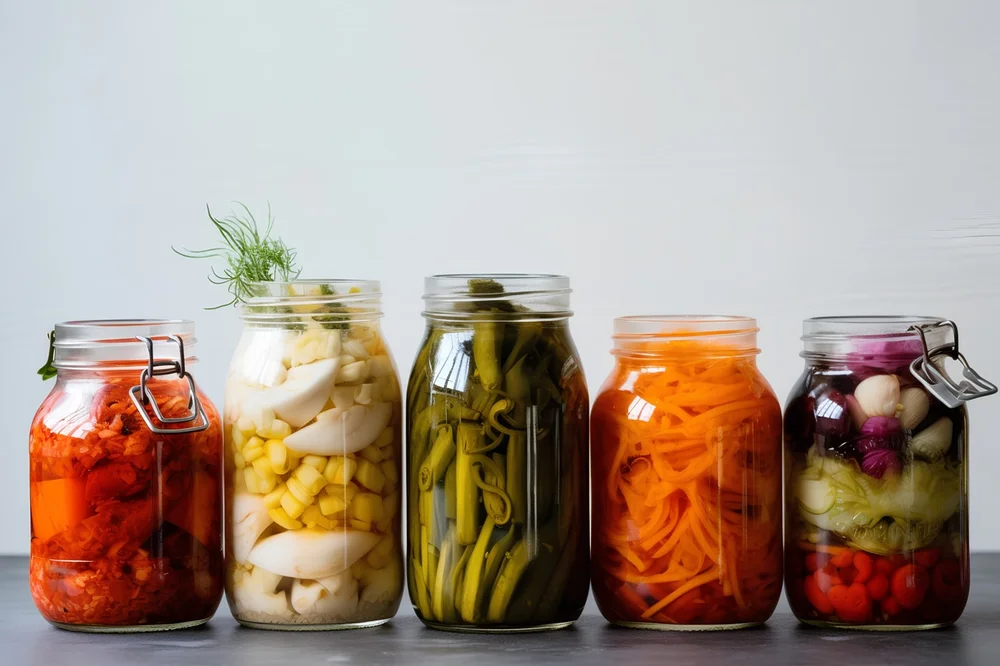Some of the Best Fermented Foods for Gut Health (Recipes Included!)
The use of fermentation to preserve foods stretches back as far as human history itself. Indeed, evidence of fermented food and beverage preparation dates back to 10,000 B.C.!
Preservation through fermentation served the critical purpose of allowing people to have vegetables and other foods throughout the winter, when food sourcing was difficult and fresh produce was scarce. Today, Epicureans value fermentation for the unique flavor it brings to foods and beverages, embellishing them with greater complexity.
Combining simple sugars with microorganisms (such as yeast or bacteria), the process of fermentation naturally alters foods by converting carbohydrates to alcohol or acids. The alcohol or acid acts as a preservative while providing a tangy flavor.
Through the natural fermentation process, cabbage turns to sauerkraut, dairy becomes yogurt or cheese, and tea becomes kombucha. These fermented foods are rich in beneficial bacteria (probiotics) and important nutrients, which make them great for gut and overall health.
Consuming fermented foods can help support a diverse and healthy intestinal microbiome – which isn’t only important for digestive health but also immune health, mental health, keeping inflammation in check, and protecting against neurodegenerative health issues.
Here are some delicious, fermented foods and beverages that can help support your gut health and enhance your meals, plus recipes for you to make some of them at home!
5 Surprisingly Delicious Fermented Foods and Beverages
These simple and delicious fermented foods and beverages are widely available at most health retailers.
- Fermented Veggies (Sauerkraut, Kimchi, and Pickles)
Sauerkraut, kimchi (both made from cabbage), and traditional pickles (pickled cucumber), preserved via natural lacto-fermentation, are delicious and loaded with probiotics.
Sauerkraut and kimchi are lovely condiments, which can be added to rice, soups, stews, sandwiches, eggs, or virtually anything you can think of. Research shows they also have anti-inflammatory properties and are good sources of vitamin C, iron, antioxidants, and fiber.
Pickles are another great condiment or snack to be enjoyed anytime. Be sure you don’t get the conventional pasteurized versions of these fermented foods as the heating process destroys all the bacteria – good and bad.
Look for labels that say “raw,” “naturally fermented,” “unpasteurized” or “contains live or active cultures.” Consume them by their expiration date and keep them refrigerated since they’re unpasteurized.
- Yogurt & Kefir
Unsweetened yogurt with the label “contains live and active cultures” is loaded with probiotic cultures. It’s delicious with added fruit, and in smoothies, salad dressings and dips, chicken dishes, and even baked goods. Try a low-fat Greek yogurt as it’s usually higher in protein. If you’re vegan, enjoy yogurt made from coconut milk.
For a tangier, yogurt-like beverage, try kefir. There are low-fat dairy and vegan, coconut-milk based varieties. Be sure to choose unsweetened and look for “contains live & active cultures” on the label. Kefir is even higher in probiotics than yogurt!
- Tempeh
Textured and nutty-tasting, tempeh is a traditional Indonesian food made from fermented soybeans. It’s a fantastic meat substitute and tastes wonderful in stir-fry recipes. It’s also a great source of protein (more than tofu) and is rich in B vitamins, fiber, iron, manganese, phosphorus, magnesium, and calcium. It’s incredibly versatile. Try layering it in sandwiches, crumbling it up to use in place of grand meat, or searing it like a steak.
- Kombucha

Some animal studies have found that kombucha may be beneficial for maintaining healthy blood sugar levels and keeping bad cholesterol in check.
- Miso
A traditional Japanese condiment, miso is a paste made from fermenting soybeans with a domesticated fungal starter, salt, and sometimes a grain such as brown rice or barley.
Though well-known here in America for its use in the eponymous soup, it also can be enjoyed in other ways. It’s distinct savory flavor and aroma lends well to stir-fries. It can offer a probiotic boost to smoothies or a savory enhancement to sauces, spreads, rice, roasted veggies, stews, meats, and soups.
Miso is both probiotic-rich and nutritious. It contains a decent amount of protein, vitamins, and minerals. Be warned that it’s high in sodium for those who need to watch their salt intake. A little goes a long way!
Fermented Food Recipes
If you want to experiment with fermentation at home, here are a couple of basic, easy fermented food recipes to get you started.
Vegan Miso Kimchi
INGREDIENTS
- 1 head Napa cabbage (approx. 1 pound), cored and leaves separated
- 1 cup filtered water
- 1 small daikon radish (approx. 4 ounces), thinly sliced into rounds
- 8 scallions, greens chopped, whites set aside
- sea salt
- 8 garlic cloves
- 1 peeled knob of ginger (about 2 inches)
- ½ cup Korean chili powder
- 2 tablespoons miso paste (red or white)
- 1 tablespoon coconut sugar
DIRECTIONS
- Toss cabbage leaves, daikon, and scallion greens in a large bowl with 2 tablespoons of sea salt. Cover and set aside until cabbage is wilted (approximately 1 to 12 hours). The cabbage will generally release about ¼ to ½ cup of liquid.
- While the cabbage is set aside, in a food processor or blender, combine scallion whites, garlic, ginger, chili powder, miso paste, and coconut sugar in a food processor or blender. Process/blend until a paste is formed (about 30 seconds). Scrape down the sides, if necessary.
- Add chili paste in with your wilted cabbage, turning the cabbage to coat. Mix in 1 cup of filtered water. Taste and add additional salt, if needed.
- Pack kimchi into mason jars. Press down firmly and pack tightly. Try using a chopstick to release any large air bubbles trapped in the bottom of the jar. Cover the kimchi with its liquid.
- Seal the jars tightly. Allow them to sit at a cooler room temperature (68-70° Fahrenheit) for 24 hours and then refrigerate. Give them at least 1 week to ferment before eating. The sour taste of the kimchi increases as it ages. It’s recommended that you consume it within one month.
Maple Kombucha Tea
Kombucha is basically sweet tea that undergoes fermentation with the addition of a SCOBY (symbiotic culture of bacteria and yeast) and starter tea from a previous batch of kombucha. A SCOBY is also known as a kombucha “mother” or kombucha culture. While you can get a “mother” from perhaps a friend who brews kombucha, your best bet is to buy a SCOBY from a reputable online retailer.
You’ll also need a small amount of starter tea. Retailers usually provide some with the SCOBY. If the retailer doesn’t provide enough starter tea, you can buy some plain, unflavored, raw store-bought kombucha.
INGREDIENTS
- 1 kombucha SCOBY and ¼ cup of kombucha starter tea
- 1 gallon of purified water
- 1¼ cup of pure maple syrup
- 5-7 tea bags of black tea (or if you prefer, try green, white, or oolong tea)
DIRECTIONS
- Bring a gallon of water to a boil for 10 minutes to remove all impurities. Remove pot from heat and pour in pure maple syrup so that it blends into the water.
- Next add your tea bags, allowing them to steep in the sweetened water until mixture cools down to room temperature (or leave them overnight).
- Remove tea bags and strain out any remnants of herbs. Pour mixture into a one-gallon jar, adding your SCOBY and ¼ cup of starter (or store bought) kombucha tea.
- Cover the top of the jar with a clean cloth (such as a tea towel or coffee filter) and secure it tightly with a rubber band. (Be careful not to let the liquid touch the cloth as it could attract fruit flies!) Set the kombucha in a room temperature cabinet for 3-4 weeks.
- After the first week, you should see a new SCOBY (also called the “daughter”) starting to form on top of the brew. That’s a sign of success!
- After 3-4 weeks, remove both the mother and the daughter and store them in the fridge with a little bit of their own kombucha to use in the future.
- Chill your kombucha and enjoy. You can use one of the stored kombucha cultures for your next batch, and you can gift your second one to a friend or neighbor!
At BrainMD, we’re dedicated to providing the highest purity nutrients to improve your physical health and overall well-being. For more information about our full list of brain healthy supplements, please visit us at BrainMD.
- What Are the 7 Healing Frequencies and Benefits of Sound Healing? - April 26, 2024
- Here Are Some of the Best Tension Release Exercises to Help You Feel Your Best! - April 17, 2024
- Foodscaping: How to Grow Healthy Foods In Your Own Garden! - April 12, 2024



